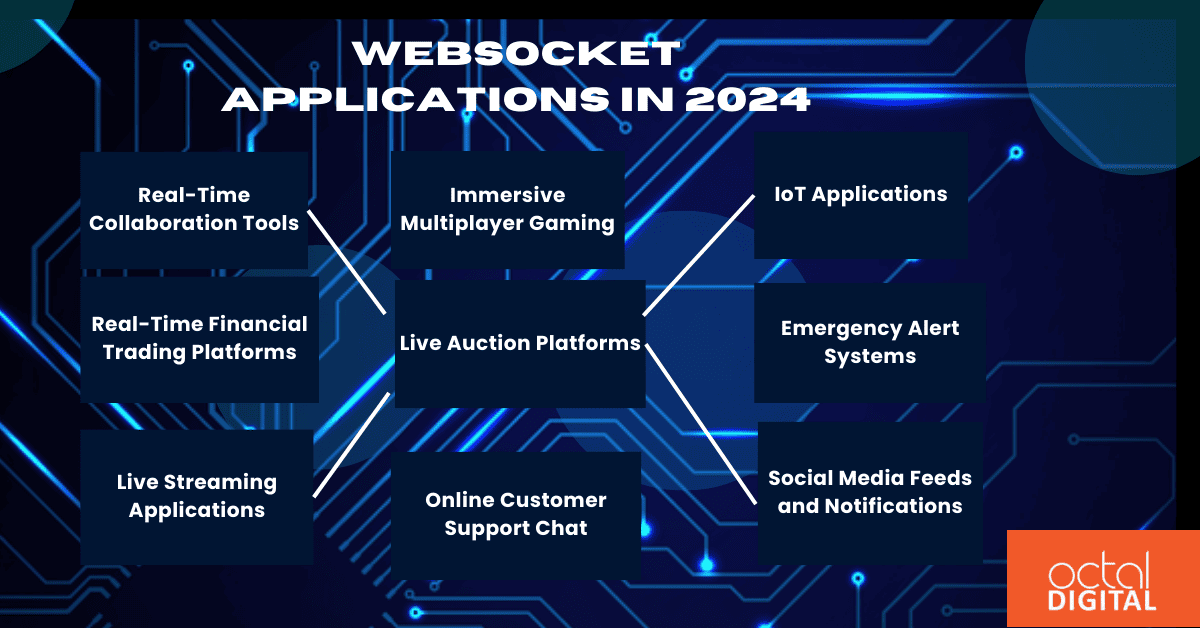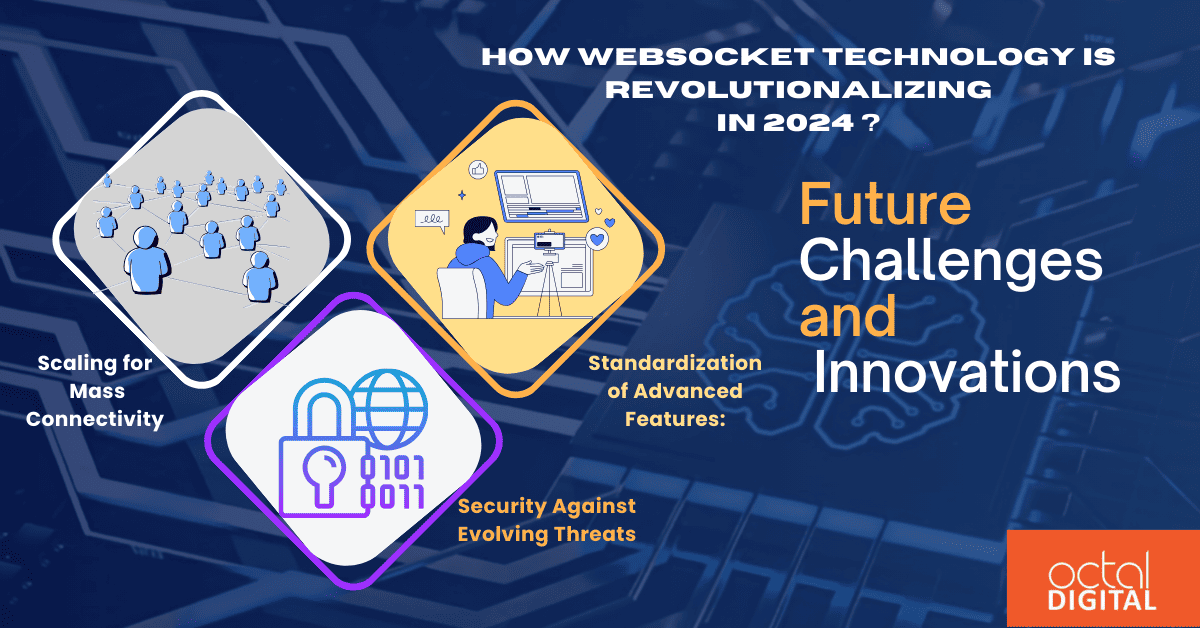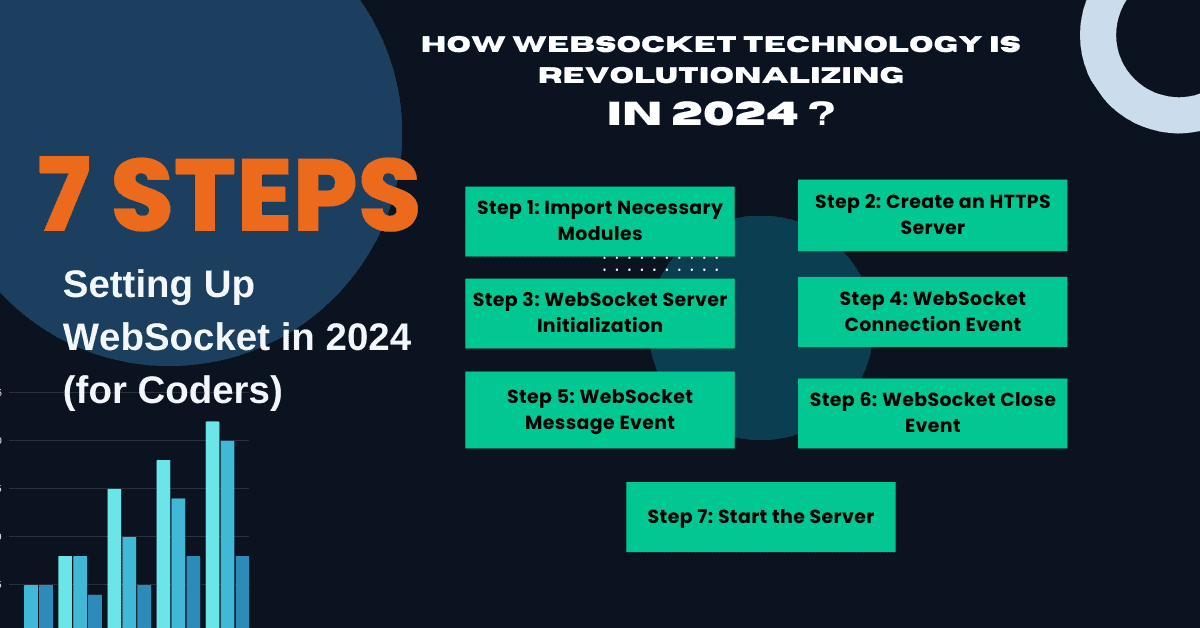2024 signifies a significant moment for real-time technologies. Among many, WebSocket is emerging as a linchpin for bidirectional, low-latency communication.
This blog aims to throw light on the latest in WebSocket technology while looking at its trends and applications in contemporary web development.
An Overview: What is WebSocket Technology?
The IETF standardized the WebSocket protocol, which is configured at the top of TCP (Transmission Control Protocol) protocol to provide full-duplex communication with a permanent connection in real-time. WebSocket is still advancing in 2024 due to protocol enhancements like better security, higher frame compression efficiency, etc. WebSocket also offers browser support as a key component of web applications.
Table of Contents
ToggleWebSocket Applications in 2024
Let’s explore some applications of WebSocket technology:

1. Real-Time Collaboration Tools:
WebSocket is known for collaborative tools through its API. It facilitates real-time editing and synchronization of documents. Operational Transformation (OT) or Conflict-Free Replicated Data Types (CRDTs) are also integrated with WebSocket to provide consistency and concurrency control for collaborative editing.
2. Immersive Multiplayer Gaming:
Its minimal latency and bidirectional connectivity make WebSocket the preferred option for online gaming. WebSockets over HTTP/2 allows for the smooth transfer of player actions, game state updates, and other real-time events.
3. IoT Applications:
WebSocket creates permanent connections for real-time control. The MQTT protocol, often used alongside WebSocket, powers efficient communication between IoT devices and servers. WebSocket’s role is used for rapid response times, such as industrial automation and smart home environments.
4. Live Auction Platforms:
Auctions that operate in real-time benefit from WebSocket’s ability to deliver instant updates to multiple bidders. Bidirectional communication ensures that all participants receive immediate notifications about new bids, ensuring a fair and dynamic auction environment. WebSocket enhances the user experience by providing bid confirmations, countdowns, and real-time updates on the bidding process.
5. Emergency Alert Systems:
Emergency response teams can use WebSocket to send real-time alerts and updates to residents in affected areas, enhancing overall preparedness and response. In incidents like natural disasters or public safety alerts, it helps in delivering instant delivery of critical information to a large number of recipients.
6. Social Media Feeds and Notifications:
WebSocket is being used by social media sites to provide real-time notifications, feed refreshes, and updates on user activity. WebSocket makes sure that the receiver knows as soon as someone leaves a message or comments on a post. In addition to improving user engagement, this real-time interaction offers a smooth social media experience.
7. Online Customer Support Chat:
WebSocket is also widely adopted in online customer support chat systems to enable real-time communication between customers and support agents. Instant messaging, file sharing, and screen sharing can be facilitated seamlessly through WebSocket, creating a responsive and efficient support environment. For instance, a customer support portal may use WebSocket to allow customers to connect with support agents instantly.
Looking for the best web design company Houston? Our Portfolio speaks for itself. Explore now!
Best Examples of Companies Implemented WebSocket Technology
| Software | Category | Description |
| Slack | Team Collaboration | Real-time messaging and collaboration platform using WebSocket for instant communication. |
| WhatsApp Web | Messaging | Web-based version of WhatsApp employing WebSocket for real-time message synchronization. |
| LiveChat | Customer Support | Customer support platform utilizing WebSocket for real-time chat interactions. |
| Trello | Project Management | Project management tool using WebSocket for real-time updates on boards and cards. |
| Online Trading Platforms (e.g., E*TRADE, TD Ameritrade) | Finance | Leveraging WebSocket for real-time updates on stock prices, market trends, and trade executions. |
| Online Gaming Platforms (e.g., Agar.io) | Gaming | Online multiplayer games are utilizing WebSocket for real-time communication between players and the game server. |
| Zoom | Video Conferencing | Video conferencing platform incorporating WebSocket for real-time audio and video communication. |
| Twitter (Live Tweets) | Social Media | Twitter uses WebSocket for live updates on tweets, notifications, and real-time interactions. |
| GitHub | Software Development | Version control and collaboration platform employing WebSocket for real-time updates on repositories. |
| Uber | Ride-Sharing | Ride-sharing platforms like Uber use WebSocket for real-time updates on driver location and trip status. |
Also Read: Complete iOS App Development Roadmap in Houston (2024)
Trends in WebSocket Technology (2024)
1. Edge Computing Integration:
WebSocket’s integration with edge computing involves deploying WebSocket servers closer to the network edge, minimizing latency by reducing the physical distance data must travel. This is achieved with the help of technologies like WebRTC and employing edge computing platforms for WebSocket server deployment.
2. Serverless Architectures:
WebSocket integrates with serverless architectures with the use of serverless computing platforms. Without needing traditional server management, serverless platforms offer support that helps developers to build event-driven and scalable applications. AWS Lambda and Azure Functions are examples of platforms supporting serverless WebSocket APIs.
3. Enhanced Security Measures:
The use of Transport Layer Security (TLS) for end-to-end encryption improves WebSocket security. Furthermore, many individuals employ token-based authentication solutions such as JSON Web Tokens (JWT) to create secure WebSocket connections. The deployment of secure WebSocket connections requires compliance with the most modern security best practices, such as severe origin validation and secure key management.
Looking for a web development company Houston, we have 12+ years of expertise in delivering robust websites that have unlocked new heights for businesses!
Setting Up WebSocket in 2024 ( for Coders)
This guide will walk you through the process using JavaScript, the Node.js runtime, and the ‘ws’ library.
A) Prerequisites:
Before you begin, ensure that the following prerequisites are met:
- Node.js and npm Installation:
- Make sure Node.js is installed on your system. If not, download and install it from https://nodejs.org/.
- npm (Node Package Manager) is bundled with Node.js, so you don’t need to install it separately.
- Secure Socket Layer (SSL) Certificates:
- Obtain SSL certificates for secure WebSocket connections. You can use tools like Let’s Encrypt or generate self-signed certificates for development purposes.
B) Step-by-Step Implementation:
Now, let’s implement a WebSocket server using JavaScript, Node.js, and the ‘ws’ library:
// Sample WebSocket server implementation using the 'ws' library and Node.js const WebSocket = require('ws'); const https = require('https'); const fs = require('fs'); // Create an HTTPS server with SSL certificates const server = https.createServer({ cert: fs.readFileSync('path/to/certificate.pem'), key: fs.readFileSync('path/to/private-key.pem') }); // Create a WebSocket server attached to the HTTPS server const wss = new WebSocket.Server({ server }); // WebSocket Connection Event wss.on('connection', (ws) => { console.log('WebSocket connection established'); // WebSocket Message Event ws.on('message', (message) => { console.log(`Received message: ${message}`); // Additional logic for handling incoming messages }); // WebSocket Close Event ws.on('close', () => { console.log('WebSocket connection closed'); }); }); // Start the HTTPS server and listen on port 3000 server.listen(3000, () => { console.log('Server is listening on port 3000'); }); |
C) Explanation:
1. Import Necessary Modules:
We begin by importing the essential modules. require(‘ws’) brings in the ‘ws’ library for WebSocket support. We also import the built-in HTTPS module (https) and File System module (fs) for creating an HTTPS server and reading SSL certificate files, respectively.
2. Create an HTTPS Server:
Next, we use the https.createServer() method to establish an HTTPS server. This involves providing the path to your Secure Socket Layer (SSL) certificate to enable HTTPS and private key files. This secure server forms the foundation for WebSocket communication.
3. WebSocket Server Initialization:
With the HTTPS server in place, we create a WebSocket server (WebSocket.Server) attached to it. This ensures that WebSocket communication is conducted over a secure connection.
4. WebSocket Connection Event:
The heart of WebSocket communication lies in the ‘connection’ event. Here, we define actions to be performed when a WebSocket connection is established. This is where you can set up initializations or authentication processes.
5. WebSocket Message Event:
The ‘message’ event handles incoming messages from WebSocket clients. This is a crucial part where you can implement custom logic to process and respond to messages in real-time.
6. WebSocket Close Event:
Handling the ‘close’ event allows you to perform cleanup tasks when a WebSocket connection is closed. This can include resource deallocation or logging relevant information.
7. Start the Server:
Finally, we initiate the server by calling server.listen(). In this example, the server listens on port 3000, and a console log confirms that the server is up and running.
Get a quote at Octal Digital today, the best web development agency Houston.
D) Running the WebSocket Server:
To put your WebSocket server into action:
- Save the provided code in a file, e.g., websocket-server.js.
- Open a terminal and navigate to the directory containing the file.
- Run the command: node websocket-server.js
Congratulations! Your WebSocket server is now operational and prepared to handle real-time communication with WebSocket clients.
Read more about how to get started with WebSocket technology at Socket.IO as a developer.
How is WebSocket Relevant with Various Frameworks?

Let’s now discover how WebSockets seamlessly blend with popular technologies like React, Python, Golang, and JavaScript. Together, they redefine user experiences, enabling dynamic, real-time communication across the web.
1. React WebSocket
Integrating WebSocket with React enhances user experiences by enabling real-time communication within applications. React’s component-based structure pairs seamlessly with WebSocket, allowing developers to create dynamic and interactive interfaces. Libraries like socket.io-client facilitate WebSocket integration, providing instant updates and live data streaming.
2. Python WebSocket
Python’s websockets and socket.io libraries make WebSocket implementation straightforward, allowing developers to build asynchronous and event-driven applications. Python’s readability and simplicity align well with WebSocket’s bidirectional communication capabilities, making it ideal for real-time features in web applications, games, and IoT systems.
3. Golang WebSocket
Golang’s native gorilla/websocket package simplifies WebSocket integration, leveraging the language’s concurrency and performance. Golang is particularly well-suited for high-throughput real-time applications, such as live streaming or financial platforms, where its scalability and efficiency enhances. The clean API of gorilla/websocket facilitates the management of WebSocket connections and events.
4. JavaScript WebSocket
JavaScript seamlessly integrates with WebSocket technology, enabling real-time communication between clients and servers. Browsers provide native WebSocket APIs, allowing JavaScript developers to establish connections directly. JavaScript’s event-driven nature aligns with WebSocket’s asynchronous model, making it ideal for dynamic web applications requiring live data updates, chat features, and collaborative tools.
Read More: WordPress vs Wix – Which Is The Best CMS 2024?
Security and Compliance in 2024
WebSocket security in 2024 involves implementing robust measures to ensure the confidentiality, integrity, and authenticity of transmitted data.
1. End-to-End Encryption:
End-to-end encryption is used to secure WebSocket communication, which adheres to the most recent TLS standards. This cryptographic protocol keeps data sent between clients and servers secure and tamper-proof.
2. Token-Based Authentication:
Tokens, most notably JSON Web Tokens (JWT), are used to authenticate WebSocket connections. Tokens are exchanged during the WebSocket handshake, which provides a secure way for authenticating client identities and authorising access to particular resources.
3. Compliance with Data Protection Regulations:
WebSocket implementations adhere to data protection regulations such as GDPR, HIPAA, and others. Compliance measures include ensuring the secure storage of authentication tokens, providing mechanisms for data subject access requests, and encrypting sensitive data transmitted via WebSocket.
Not only web development, but we also have a stronghold for mobile app development Houston. Get your quote today!
Future Challenges and Innovations

As WebSocket technology progresses, certain challenges and ongoing innovations are shaping its trajectory.
1. Scaling for Mass Connectivity:
Scaling WebSocket applications to accommodate a massive number of simultaneous connections requires innovative approaches. Load balancing, microservices architecture, and the use of edge computing are strategies employed to address this challenge.
2. Standardization of Advanced Features:
The evolution of real-time technologies introduces new features and capabilities for WebSocket. Standardizing these features across WebSocket implementations is crucial for ensuring interoperability and widespread adoption. Efforts by organizations like the IETF and W3C play a key role in standardizing these advancements.
3. Security Against Evolving Threats:
Continuous monitoring of emerging threats and proactive measures, such as implementing rate limiting and intrusion detection systems, are necessary for securing WebSocket applications.
Must Read 6 Mobile App Development Categories On The Rise in 2024
Conclusion:
In conclusion, the state of real-time online communication in 2024 will be capped by WebSocket technology. The combination of applications, trends, and practical lessons highlights the usefulness and relevance of WebSocket in the present technological landscape.
As the real-time landscape continues to evolve, staying attuned to WebSocket advancements ensures continued relevance and innovation.
FAQ’s
1. What does it mean when the WebSocket is closed before the connection is established?
Several factors can contribute to this issue:
- Network Problems: Connectivity issues, firewalls, or network restrictions can hinder the WebSocket handshake.
- Incorrect URL or Endpoint: A misconfigured URL or WebSocket endpoint on either the client or server side can lead to closure.
- Security Restrictions: Browser security policies or server configurations might prevent the WebSocket handshake.
2. How can I troubleshoot and diagnose the issue of a WebSocket closing prematurely?
- Check Network Connectivity: Ensure there are no network issues, firewalls, or proxies interfering with the WebSocket connection.
- Verify URL and Endpoints: Double-check that the client and server are using the correct WebSocket URL and endpoints.
- Review Server Logs: Examine server logs for any error messages or indications of failed WebSocket handshakes.
- Browser Developer Tools: Use browser developer tools to inspect WebSocket-related errors in the console.
- Try a WebSocket Testing Tool: Utilize online WebSocket testing tools to check the connection from different locations.








